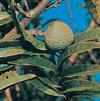- custard apple
-
2. any of several other trees, as the pawpaw, Asimina triloba, bearing fruit with soft, edible pulp.3. the fruit of any of these trees.[1650-60]
* * *
Any of various Annona species of shrubs or small trees of the family Annonaceae, native to the New World tropics and Florida.The family is the largest in the magnolia order and contains approximately 1,100 species of plants in 122 genera. Many species in the family are valuable for their large, pulpy fruits. Others are valued for their timber, and still others as ornamentals. Leaves and wood are often fragrant. The fruit is a berry. The small, tropical American custard apple (Annona reticulata) bears fruits with reddish-yellow, sweetish, custardlike flesh. Other species include the sweetsop (A. squamosa) and the soursop (A. muricata). Bark, leaves, and roots of many species are important in folk medicine. Custard apple (Annona reticulata).Walter Dawn
Custard apple (Annona reticulata).Walter Dawn* * *
▪ plantany of various Annona species of small trees or shrubs of the Annonaceae family, native to the New World tropics and Florida, or their fruits. The fruit of the common custard apple (A. reticulata), also called sugar apple or bullock's-heart in the West Indies, is dark brown in colour and marked with depressions giving it a quilted appearance; its pulp is reddish yellow, sweetish, and very soft (hence the common name); the kernels of the seeds are said to be poisonous. The soursop, or guanabana, is the fruit of A. muricata, native to the West Indies. The sweetsop is produced by A. squamosa, a native of tropical America and widely cultivated in the tropics. A. cherimola yields the cherimoya, a much-esteemed fruit of superior flavour. alligator apple, or corkwood (A. glabra), a native of South America and West Africa, is valued for its roots, which serve the same purposes as cork; the fruit, commonly known as the alligator apple or pond apple, is not eaten fresh but is sometimes used for making jellies.* * *
Universalium. 2010.
